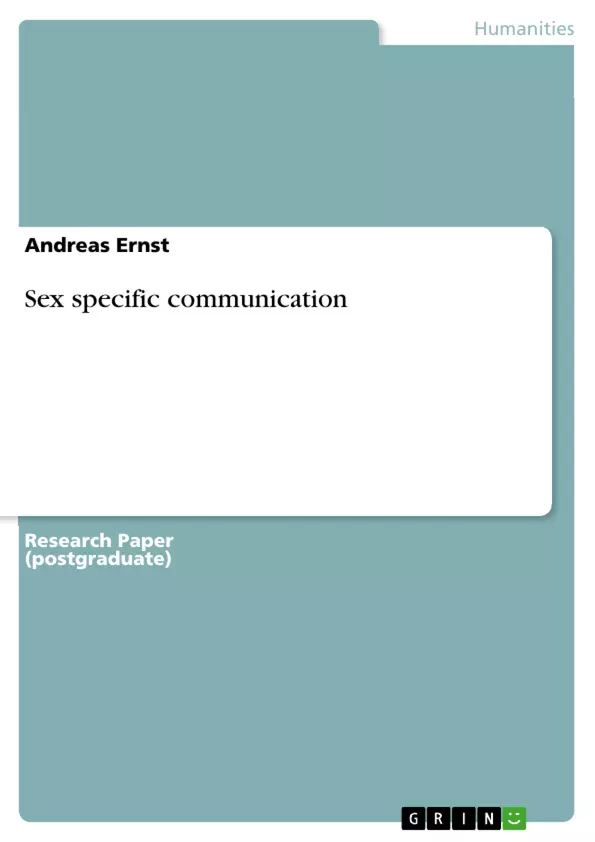Since the beginning of time humans have been trying to put the world into scientific formulas. This constant search for all the coherence, which defines our reality, affects today’s civilisation and its achievements essentially. But not always has science led to enlightenment of humankind. It was used repeatedly to endorse existing prejudices and malicious thoughts. At the end of the day empirical and absolutely subjective research only exist in our minds, that science is and always will be a thin line surrounded by deep abysses.
This paper should be regarded as a pre-experiment serving towards the exploration of polyphony in both genders. The rise of short messaging service (SMS) enables to conduct research with modest effort. More and more one should ask what necessity an additional paper has, since this topic is already considered as well explored. Therefore it is important to emphasise that this paper is not another attempt to justify existing prejudices in a wannabe scientific manner.
We, as a group are convinced, that every human being is unique and that there is ultimately no way to categorise this uniqueness without narrowing its diversity.
Nonetheless we intend to examine following two points. On one hand, if there are any tendencies of linguistic habit, which are consistent with the existing theory. But most of all if it possible for regular people (i.e. not specifically trained) to recognise a sex specific communication. Finally, one should keep in mind, that this experiment only represents a snapshot of our personal live, and environment, and should be treated as such.
Inhaltsverzeichnis (Table of Contents)
- Introduction
- Theoretical Background
- Sex-specific communication and characteristics of perceptibility
- The Development of a different language
- Metacommunication
- The language of women
- The language of men
- How to deal with sex-specific communication
- Individuality concerning the communication as medium
- Sex-specific communication and characteristics of perceptibility
- Experiment
- Construction
- Execution
- Findings
- Quantitive analysis
- Qualitative analysis
- Applicability
- Internal communication
- External communication
- Conclusion
Zielsetzung und Themenschwerpunkte (Objectives and Key Themes)
This paper aims to explore the concept of polyphony in both genders, specifically examining whether there are discernible tendencies in linguistic habits that align with existing theories. It also investigates whether individuals, without specific training, can recognize sex-specific communication. The research utilizes short messaging service (SMS) as a tool for data collection.
- Sex-specific communication patterns
- The role of education and social expectations in shaping language use
- The impact of metacommunication on gendered communication styles
- The ability of individuals to identify sex-specific communication
- The potential limitations of using SMS as a research tool
Zusammenfassung der Kapitel (Chapter Summaries)
- Introduction: The introduction sets the stage for the research by discussing the historical context of scientific inquiry and the challenges of categorizing human behavior, emphasizing the need to avoid perpetuating prejudices. It introduces the two main focuses of the paper: examining existing theories of linguistic habits and exploring the ability of individuals to recognize sex-specific communication.
- Theoretical Background: This chapter delves into the historical and theoretical foundations of sex-specific communication. It discusses the historical imbalance in societal roles between men and women, arguing that this led to the development of distinct modes of thinking and communication. The authors cite feminist theorists who support this notion and highlight the role of education and social expectations in shaping gendered communication styles.
- Sex-specific communication and characteristics of perceptibility: This section explores the specific aspects of sex-specific communication, including the development of different languages due to differing social expectations and the impact of metacommunication on communication styles. It presents a communication model that highlights the different aspects of a message and how men and women may prioritize these aspects differently.
- Experiment: This chapter outlines the experiment conducted to gather data on sex-specific communication. It describes the construction and execution of the experiment, providing details on the methodology and data collection process.
- Findings: This section presents the findings of the experiment, including both quantitive and qualitative analysis of the collected data.
- Applicability: This chapter explores the potential applications of the research findings, considering both internal and external communication contexts.
Schlüsselwörter (Keywords)
The main focus of this work lies on the exploration of sex-specific communication and its impact on social interactions. Key concepts include gendered language, metacommunication, the influence of social expectations on communication, and the development of distinct linguistic habits between men and women. The research utilizes short messaging service (SMS) as a data collection tool, highlighting the potential of digital communication for exploring communication patterns.
- Citation du texte
- Andreas Ernst (Auteur), 2003, Sex specific communication, Munich, GRIN Verlag, https://www.grin.com/document/13186



